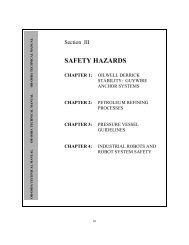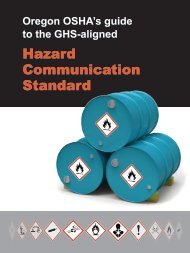Western Pulp & Paper Workers Safety & Health Conference
Western Pulp & Paper Workers Safety & Health Conference
Western Pulp & Paper Workers Safety & Health Conference
You also want an ePaper? Increase the reach of your titles
YUMPU automatically turns print PDFs into web optimized ePapers that Google loves.
Sessions<br />
10-10:15 a.m.<br />
Break<br />
11:30 a.m.-1 p.m.<br />
Lunch (provided)<br />
Prize drawing at noon<br />
SESSION 7<br />
1-2:30 p.m.<br />
OSHA 10 hour for General Industry<br />
(Continued from Wednesday; concludes at 4:30 p.m.)<br />
Proven Strategies for Improving<br />
<strong>Safety</strong> Committee Effectiveness<br />
(Continued from 8:30 a.m.; concludes at 4:30 p.m.)<br />
Root Cause Analysis (1-4:30 p.m.)<br />
This session is an introduction to the concept of root<br />
cause analysis and its role in the accident investigation<br />
process. Several root cause analysis tools are reviewed,<br />
and an example root cause analysis is presented.<br />
Linda Pressnell<br />
Public Education Trainer<br />
Oregon OSHA, Portland<br />
Compressed Gas <strong>Safety</strong><br />
Compressed gas safety encompasses the safe handling<br />
of compressed gas cylinders (oxygen, acetylene,<br />
propane, argon, etc.) in use and in storage. Discussion<br />
includes the safe and proper use of oxy-fuel gas<br />
equipment including proper torch adjustment and<br />
the use of heating equipment (rosebuds) and oxygen<br />
lances. Also discussed is the use and hazards of<br />
compressed gases in confined spaces.<br />
Rob Cameron<br />
Northern Oregon Sales Manager<br />
Airgas-Norpac, Inc., Longview, Washington<br />
Contractor <strong>Safety</strong> Management<br />
This session reviews the systems that need to be<br />
established to manage risks associated with using<br />
contractors. Facilities that have contractors perform<br />
work need to ensure that an established system is<br />
developed to mitigate risks to personnel and facilities<br />
and reduce the chance of incidents while contractors<br />
are working on site. The method for this risk reduction<br />
is a Contractor <strong>Safety</strong> and <strong>Health</strong> Program that<br />
evaluates the potential for hazards prior to beginning<br />
of both routine and non-routine work by Contractors<br />
on sites and by ensuring that the risks are minimized or<br />
eliminated.<br />
Georgia Pacific representatives<br />
Mobile Equipment Roundtable<br />
(1-4:30 p.m.)<br />
Hundreds of workers are injured and killed each year<br />
when they are struck by mobile equipment. What<br />
can your company can do to prevent tragedy around<br />
mobile equipment? Come to this roundtable and share<br />
your safety tips and learn from the other attendees.<br />
Facilitators:<br />
Lou Flores<br />
DOSH, Olympia, Washington<br />
Technical Resources:<br />
Joe Camacho<br />
Regional <strong>Safety</strong> & Environmental Coordinator<br />
Papé Material Handling, Seattle, Washington<br />
Craig Hamelund<br />
Education Specialist<br />
Oregon OSHA, Portland<br />
Rob Vetter<br />
Director of Training<br />
Ives Training Group, Blaine, Washington<br />
The Truth of an Industrial Injury<br />
(repeated at 3 p.m.)<br />
Hear how an industrial injury/accident impacts every<br />
aspect of your life and the lives of those who care about<br />
you.<br />
Matt Pomerinke<br />
<strong>Paper</strong>maker/<strong>Safety</strong> Representative<br />
Longview Fibre <strong>Paper</strong> & Packaging<br />
Longview, Washington<br />
2:30-3 p.m.<br />
Break<br />
15

















